Finding Lost Voices: The Islands Underneath Between Ruth Asawa (1926 -2013) and Marguerite Wildenhain (1896 - 1985)
A weekly email that brings back the voices of those who have been forgotten or misremembered
I will be going on a research trip to England, May 21–29, and am looking for donations to help cover the cost. If you appreciate the work I’m doing, please consider becoming a paid subscriber to this Substack. Every dollar I receive goes to researching the lives of forgotten or misremembered women.
“Islands”
by Muriel Rukeyser
O for God’s sake
they are connected
underneath
They look at each other
across the glittering sea
some keep a low profile
Some are cliffs
The bathers think
islands are separate like them
This poem, by Muriel Rukeyser, has always haunted me. In many ways, what it illuminates — that even when they appear isolated, women are connected underneath through networks we cannot see — has created a map for how I do my research and live my life.
This week, I’ll be writing about the American artist, Ruth Asawa (1926 - 2013). Luckily, to many in the art world, she is not unknown. But the way her life was connected to so many other women, underneath the narrative we usually see, was something I had never been aware of. This week, my post will explore the connections between two important female artists.
A few days ago, I drove down to San Francisco to the Museum of Modern Art to meet some friends and visit the Ruth Asawa exhibit. Before this excursion, I was familiar with her work, but I’d never seen it in person (or at least I didn’t realize I had). The word embody is important when you think of Asawa’s work because when you see it, her work embodies you, encases you in its spectacular form. I don’t know what I had expected walking into the gallery, but what happened when I saw her intricate metal basket-like sculptures hanging was utterly overwhelming.
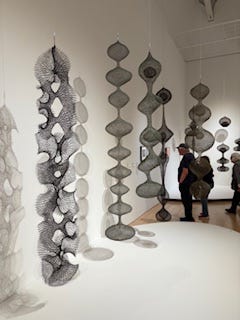
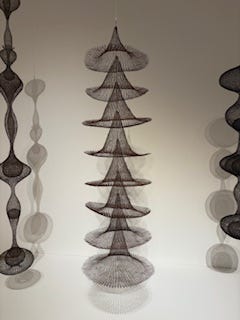
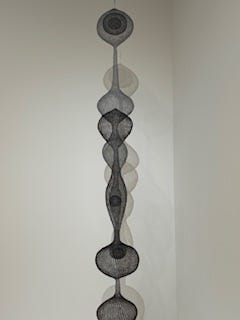
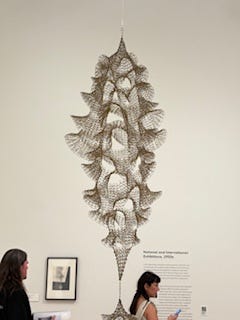
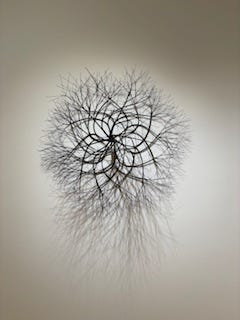
The exhibit at the MoMA takes you through the development of her artistic career — from her early days at the Black Mountain School to her later years, when she lived in Noe Valley, San Francisco, in a house where she completely integrated her art into her daily life. We wandered through the twelve galleries in awe. Then suddenly, in one of the last rooms, I saw a familiar name written on the wall: Margarite Wilderhain. Wilderhain is a German-born Bauhaus-trained ceramist who lived in Sonoma County at Pond Farm (you can see my full post about her here). As I moved through the room, I saw more and more of Wilderhain’s influence on Asawa emerge. Wilderhain introduced Asawa to working with clay, and from this, Asawa began making masks of everyone who came to visit her at her Noe Valley home, decorating the outside walls with these faces. Then, I saw a piece of Wilderhain’s pottery that Asawa had displayed in her home. Then, another.
At the gift shop, I dove into her biography Everything She Touched by Marilyn Chase. I found that indeed Asawa and Wilderhain had crossed paths, possibly at the Black Mountain School, and that Asawa and her family had a summer home in Guernville in Sonoma County near Wilderhain’s studio home at Pond Farm. I also found out that Asawa’s son, Paul, studied with Wilderhain for three summers. Here, there were these two “islands” of female artists I knew, but I had no idea they were connected (and in hindsight, of course they were!) So, I’ve spent the last few days deeply entangled in this research question: how were Ruth Asawa and Margarite Wilderhain connected, and what can we gain by looking at their friendship?
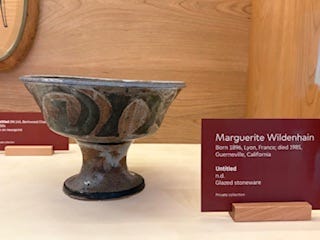

Ruth Asawa was born in Norwalk, CA on January 24, 1926. Her parents, Umakichi and Haru Asawa, were truck farmers who cultivated a variety of seasonal crops, including strawberries, carrots, green beans, and tomatoes. They were also Japanese immigrants who, due to the discriminatory laws in place in California at that time, were unable to own land or become U.S. citizens. Asawa grew up on a farm, which meant that, beginning at a young age, she worked hard daily doing jobs such as starting and stoking the woodfire that kept the ofuro, or bath, water hot every evening.
It was during the long, solitary hours she had on the farm that she began to see the world artistically. As she remembered, “I used to sit on the back of the horse-drawn leveler with my bare feet drawing forms in the sand, which later in life became the bulk of my sculptures.” Then, in February 1942 Asawa’s father, Umakichi, was arrested by the FBI and sent to a Justice Department Camp in New Mexico. A few months later, Asawa and the rest of her family were interned for six months at Santa Anita Race Track. Then the family was transported to the Rohwer Relocation Center in Arkansas, where they were imprisoned along with eight thousand other Japanese Americans.
After graduating from high school in the camp, Asawa attended Milwaukee State Teachers College in Wisconsin; however, she was unable to complete her student teaching requirement because of the terrible hostility still present at the time against anyone of Japanese descent. Instead, on the recommendation of a few friends, Asawa traveled to North Carolina to spend the summer studying art at Black Mountain College. Founded in 1933, the liberal arts college was inspired by John Dewey's educational philosophy, which encouraged students to learn through a holistic study of art. Asawa loved being fully immersed in the artistic community, including her teachers: the painter Josef Albers, dancer Merce Cunningham, and architect/inventor Buckminster Fuller. She became enmeshed in a community of peers who were equally dedicated to art, and not only did she learn to see the world differently, but she also realized how she could live as an artist the rest of her life.
In 1947, she took a trip to visit her mentors Josef and Anni Albers in Toluca, Mexico, where she studied with local basket weavers and became fascinated with the idea of weaving sculptures out of wire using their weaving techniques. Because she was fully immersed in the arts, her sculpture bloomed from the influence of Anni Albers’ Bauhaus weaving techniques, who believed in the ability of the textile to communicate with us, and the bodily space she created in Merce Cunningham’s dance classes.

Asawa would go on to marry her classmate, Albert Lanier, who became an architect, and forge a life in San Francisco deeply rooted in art. As a young bride, she confided in her friend, the renowned photographer Imogen Cunningham, that she dreamed of having six children. Cunningham told her she couldn’t have that many children and still create art. Cunningham had given her a great deal of invaluable advice over the years (such as publishing her art under her maiden name, Asawa, instead of her married name, Lanier), but on this, she didn’t listen. Asawa would have four biological children and adopt two, and her commitment to art still structured her whole life. Her kids remember art supplies being interspersed among the dry goods in the pantry. And their mother’s art projects are everywhere in their living space.
In Asawa’s biography, there is no mention of Wildenhain until 1954, when the two were part of a four-person show at the San Francisco Museum of Art in Civic Center (the precursor to the Museum of Modern Art, where I saw her show last week). It was likely that the two women met through Asawa’s mentors, the Albers. Wilderhain, who was the only woman to achieve the Master Potter designation, was a peer of the Albers at Weimar Bauhaus. Like Asawa, Wilderhain was concerned by how few people were willing to dedicate themselves to an art fully, or “to live from he work of their hands,” which led her to establish Pond Farm.
In the biography, there is no mention of Wilderhain in Asawa’s life until six years later.
In 1960, as Asawa and her family were remodeling their new house in Noe Valley, they purchased a rustic barn in Guerneville, located near Pond Farm, where Wilderhain ran her Pottery Workshop. Why would Asawa purchase a home so close to Wilderhain unless the two were friends? What happened between these two events? Did the two correspond?
This is where Rukeyser's islands come into play. From the surface of the biography, we don’t see the relationship developing underneath. Had Wilderhain told Asawa about the barn being for sale? Or had they seen it during a visit to her Pond Farm property? And were they together at Pond Farm that summer in the old barn filled with pottery wheels when Wilderhain first introduced Asawa to working in the medium of clay? It was after this summer together that Asawa began making masks of each of the visitors she had invited over to her Noe Valley home. Guests would be invited to come over, lunch would be provided, and then asked also to include an hour for her to create a cast of their face. After a farm-to-table lunch, their faces would be smeared with Vaseline, straws would be placed in their nostrils, and then they would be covered in plaster to create a mold for the clay.
The answers to these questions are lurking there silently below the surface like a lifeline.
I found a few facts in an article about an exhibit of Asawa’s work at the Sonoma County Museum from 2008. As it turns out, the two artists had first met while at Black Mountain, when Wildenhain, who was visiting to scout talent that she could lure back to her Pond Farm studio in Guerneville, up above Armstrong Redwoods. When Asawa and her husband moved to San Francisco, they made regular trips up north to Pond Farm. To such an extent that they fell in love with life under the redwoods and purchased the old barn in 1960.
It makes sense that there was an exhibit of Asawa’s work in Sonoma County because one of the last public fountains that she created during her lifetime was erected here in Santa Rosa at Courthouse Square in the 1980s. In her 2013 article about the artist, Gaye LeBaron remembers how, “her bas-relief friezes depicting Sonoma County's history and its coastal wonders transformed a rather ordinary fountain in Old Courthouse Square into a genuine work of art.” LeBaron, along with other Sonoma County luminaries, and school children, visited Asawa at her Noe Valley home to help her envision and refine some of the details that would comprise the friezes depicting Sonoma County history. However, if you visit Courthouse Square today, you won’t find the fountain that LeBaron and others had a hand in creating, because when the city decided to close the street that ran through Courthouse Square, they removed the fountain, promising to reinstall it at a later time. Years have passed, though, and still the fountain has not returned.
So the life line is starting to come into view between these two artists and their friendship that bloomed in Sonoma County, but there is so much more to find. This fall, while on residency at Pond Farm, I plan to hold my breath and dive in. How will we ever truly know the lives of women if we don’t also see the networks through which they connected?
For More Information About Ruth Asawa
Everything She Touched: The Life of Ruth Asawa, by Marilyn Chase
Leap Before you Look: Black Mountain College 1933- 1957 by Helen Molesworth
Upcoming Events
May
May 16 - 6:00 PM 36th Annual Oklahoma Book Awards - Riding Like the Wind: The Life of Sanora Babb nominated for nonfiction, National Cowboy and Western Heritage Museum, 1700 NE 63rd St., Oklahoma City, OK
May 17 - 5:30 - 7:00 PM - Iris Jamahl Dunkle at the National Steinbeck Center, Salinas, CA
May 20 - 6:00 - 8:00 PM Iris Jamahl Dunkle, Dana Gioia and Elise Paschen Reading at Dominican Edgehill Mansion 75 Magnolia Avenue San Rafael, CA 94901










I love both of these artists and LOVE knowing that they knew one another and that our redwoods sheltered them both. Thank you, Iris, for beginning to weave the wires of their relationship into visibility. I've not been to the Exhibit yet, but when I go, I'll be walking with you, after that vivid description of the 12 galleries...
It's an incredible exhibition! How did she have six children and make that much detail oriented labor intensive art? I love her.